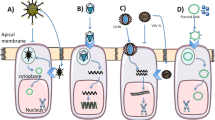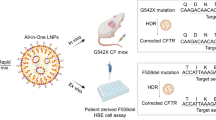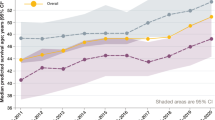Abstract
Gene therapy is currently being evaluated for a wide range of acute and chronic lung diseases. The requirement of gene transfer into the individual cell types of the complex lung structure will very much depend on the target disease. Over the last decade, the gene therapy community has recognized that there is not even one vector that is good for all applications, but that the gene transfer agent has to be carefully chosen. Gene therapy is particularly attractive for diseases that currently do not have satisfactory treatment options and probably easier for monogenic disorders than for complex diseases. Cystic fibrosis (CF) fulfills these criteria and is therefore a good candidate for gene therapy-based treatment. This review will focus on CF as an example for lung gene therapy and discuss the progress made in this field over the last couple of years.
This is a preview of subscription content, access via your institution
Access options
Subscribe to this journal
Receive 12 print issues and online access
$259.00 per year
only $21.58 per issue
Buy this article
- Purchase on Springer Link
- Instant access to full article PDF
Prices may be subject to local taxes which are calculated during checkout



Similar content being viewed by others
References
Breeze RG, Wheeldon EB . The cells of the pulmonary airways. Am Rev Respir Dis 1977; 116: 705–777.
Welsh M, Ramsey BW, Accurso F, Cutting GR . Cystic fibrosis. In: Scriver AB, Sly WS, Valle D (eds). The Molecular and Metabolic Basis of Inherited Disease. McGraw-Hill: New York, 2001, pp 5121–5188.
Riordan JR et al. Identification of the cystic fibrosis gene: cloning and characterization of complementary DNA. Science 1989; 245: 1066–1073.
Alton EW et al. Non-invasive liposome-mediated gene delivery can correct the ion transport defect in cystic fibrosis mutant mice. Nat Genet 1993; 5: 135–142.
Drumm ML et al. Correction of the cystic fibrosis defect in vitro by retrovirus-mediated gene transfer. Cell 1990; 62: 1227–1233.
Engelhardt JF et al. Expression of the cystic fibrosis gene in adult human lung. J Clin Invest 1994; 93: 737–749.
Ferrari S, Griesenbach U, Geddes DM, Alton E . Immunological hurdles to lung gene therapy. Clin Exp Immunol 2003; 132: 1–8.
Weiss DJ . Delivery of gene transfer vectors to lung: obstacles and the role of adjunct techniques for airway administration. Mol Ther 2002; 6: 148–152.
Ferrari S, Geddes DM, Alton EW . Barriers to and new approaches for gene therapy and gene delivery in cystic fibrosis. Adv Drug Deliv Rev 2002; 54: 1373–1393.
Pickles RJ et al. Retargeting the coxsackievirus and adenovirus receptor to the apical surface of polarized epithelial cells reveals the glycocalyx as a barrier to adenovirus-mediated gene transfer. J Virol 2000; 74: 6050–6057.
Worgall S et al. Role of alveolar macrophages in rapid elimination of adenovirus vectors administered to the epithelial surface of the respiratory tract. Hum Gene Ther 1997; 8: 1675–1684.
Katkin JP et al. Aerosol delivery of a beta-galactosidase adenoviral vector to the lungs of rodents. Hum Gene Ther 1995; 6: 985–995.
Scaria A et al. Adenovirus-mediated persistent cystic fibrosis transmembrane conductance regulator expression in mouse airway epithelium. J Virol 1998; 72: 7302–7309.
Harvey BG et al. Safety of local delivery of low- and intermediate-dose adenovirus gene transfer vectors to individuals with a spectrum of morbid conditions. Hum Gene Ther 2002; 13: 15–63.
Joseph PM et al. Aerosol and lobar administration of a recombinant adenovirus to individuals with cystic fibrosis. I. Methods, safety, and clinical implications. Hum Gene Ther 2001; 12: 1369–1382.
Walters RW et al. Basolateral localization of fiber receptors limits adenovirus infection from the apical surface of airway epithelia. J Biol Chem 1999; 274: 10219–10226.
Gregory LG et al. Enhancement of adenovirus-mediated gene transfer to the airways by DEAE dextran and sodium caprate in vivo. Mol Ther 2003; 7: 19–26.
Harvey BG et al. Airway epithelial CFTR mRNA expression in cystic fibrosis patients after repetitive administration of a recombinant adenovirus. J Clin Invest 1999; 104: 1245–1255.
Toietta G et al. Reduced inflammation and improved airway expression using helper-dependent adenoviral vectors with a K18 promoter. Mol Ther 2003; 7: 649–658.
Aitken ML et al. A phase I study of aerosolized administration of tgAAVCF to cystic fibrosis subjects with mild lung disease. Hum Gene Ther 2001; 12: 1907–1916.
Wagner JA et al. Efficient and persistent gene transfer of AAV-CFTR in maxillary sinus. Lancet 1998; 351: 1702–1703.
Moss RB et al. Repeated adeno-associated virus serotype 2 aerosol-mediated cystic fibrosis transmembrane regulator gene transfer to the lungs of patients with cystic fibrosis: a multicenter, double-blind, placebo-controlled trial. Chest 2004; 125: 509–521.
Duan D, Yue Y, Engelhardt JF . Expanding AAV packaging capacity with trans-splicing or overlapping vectors: a quantitative comparison. Mol Ther 2001; 4: 383–391.
Halbert CL, Allen JM, Miller AD . Efficient mouse airway transduction following recombination between AAV vectors carrying parts of a larger gene. Nat Biotechnol 2002; 20: 697–701.
Calcedo R, Gallery L, Gao G, Wilson J . Serological characterisation of human and non-human primate AAVs. Mol Ther 2003; 7: S41 (abstract).
Zabner J et al. Adeno-associated virus type 5 (AAV5) but not AAV2 binds to the apical surfaces of airway epithelia and facilitates gene transfer. J Virol 2000; 74: 3852–3858.
Xie Q et al. The atomic structure of adeno-associated virus (AAV-2), a vector for human gene therapy. Proc Natl Acad Sci USA 2002; 99: 10405–10410.
Shi W, Bartlett JS . RGD inclusion in VP3 provides adeno-associated virus type 2 (AAV2)-based vectors with a heparan sulfate-independent cell entry mechanism. Mol Ther 2003; 7: 515–525.
Beck SE et al. Repeated delivery of adeno-associated virus vectors to the rabbit airway. J Virol 1999; 73: 9446–9455.
Halbert CL et al. Transduction by adeno-associated virus vectors in the rabbit airway: efficiency, persistence, and readministration. J Virol 1997; 71: 5932–5941.
Auricchio A et al. Noninvasive gene transfer to the lung for systemic delivery of therapeutic proteins. J Clin Invest 2002; 110: 499–504.
Fischer A et al. Successful transgene expression with serial doses of aerosolized rAAV2 vectors in Rhesus macaques. Mol Ther 2003; 8: 918–926.
Ferrari S et al. Recombinant Sendai virus-mediated CFTR cDNA transfer. Mol Ther 2003; 7: S38 (abstract).
Zhang L, Pepples M, Collins P, Pickles R . RSV and PIV3 target human ciliated airway epithelial cells: efficient gene transfer vectors for cystic fibrosis lung disease. Mol Ther 2003; 7: S36 (abstract).
Inoue M et al. A new Sendai virus vector deficient in the matrix gene does not form virus particles and shows extensive cell-to-cell spreading. J Virol 2003; 77: 6419–6429.
Wang G et al. Apical barriers to airway epithelial cell gene transfer with amphotropic retroviral vectors. Gene Therapy 2002; 9: 922–931.
Limberis M, Anson DS, Fuller M, Parsons DW . Recovery of airway cystic fibrosis transmembrane conductance regulator function in mice with cystic fibrosis after single-dose lentivirus-mediated gene transfer. Hum Gene Ther 2002; 13: 1961–1970.
Sinn PL et al. Lentivirus vectors pseudotyped with filoviral envelope glycoproteins transduce airway epithelia from the apical surface independently of folate receptor alpha. J Virol 2003; 77: 5902–5910.
Kobayashi M, Iida A, Ueda Y, Hasegawa M . Pseudotyped lentivirus vectors derived from simian immunodeficiency virus SIVagm with envelope glycoproteins from paramyxovirus. J Virol 2003; 77: 2607–2614.
Fajac I, Briand P, Monsigny M, Midoux P . Sugar-mediated uptake of glycosylated polylysines and gene transfer into normal and cystic fibrosis airway epithelial cells. Hum Gene Ther 1999; 10: 395–406.
Fajac I et al. Uptake of plasmid/glycosylated polymer complexes and gene transfer efficiency in differentiated airway epithelial cells. J Gene Med 2003; 5: 38–48.
Klink D, Yu QC, Glick MC, Scanlin T . Lactosylated poly-L-lysine targets a potential lactose receptor in cystic fibrosis and non-cystic fibrosis airway epithelial cells. Mol Ther 2003; 7: 73–80.
Ziady AG et al. Functional evidence of CFTR gene transfer in nasal epithelium of cystic fibrosis mice in vivo following luminal application of DNA complexes targeted to the serpin-enzyme complex receptor. Mol Ther 2002; 5: 413–419.
Cunningham S et al. Evaluation of a porcine model for pulmonary gene transfer using a novel synthetic vector. J Gene Med 2002; 4: 438–446.
Konstan M et al. Single dose escalation study to evaluate safety of nasal administration of CFTR001 gene transfer vector to subjects with cystic fibrosis. Mol Ther 2003; 7: S386 (abstract).
Yew NS et al. Reduced inflammatory response to plasmid DNA vectors by elimination and inhibition of immunostimulatory CpG motifs. Mol Ther 2000; 1: 255–262.
Gill DR et al. Increased persistence of lung gene expression using plasmids containing the ubiquitin C or elongation factor 1alpha promoter. Gene Therapy 2001; 8: 1539–1546.
Yew NS et al. High and sustained transgene expression in vivo from plasmid vectors containing a hybrid ubiquitin promoter. Mol Ther 2001; 4: 75–82.
Machado-Aranda D, Adir Y, Sznajader A, Dean D . Electroporation-mediated transfer of the Na-K-ATpase b1 subunit safely increases alveolar fluid clearance in rat lungs. Mol Ther 2003; 7: S381 (abstract).
Fox E et al. Towards nucleic acid transfer to the airway epithelium via the systemic route. Mol Ther 2002; 5: S197 (abstract).
Koehler DR et al. Targeting transgene expression for cystic fibrosis gene therapy. Mol Ther 2001; 4: 58–65.
Ferkol T et al. Gene transfer into the airway epithelium of animals by targeting the polymeric immunoglobulin receptor. J Clin Invest 1995; 95: 493–502.
Griesenbach U et al. Conversion of wild-type CFTR to the G551D mutation in primary rat hepatocytes using RNA/DNA oligonucleotides. Pediat Pulmonol 2001; 32: 252 (abstract).
Goncz KK, Kunzelmann K, Xu Z, Gruenert DC . Targeted replacement of normal and mutant CFTR sequences in human airway epithelial cells using DNA fragments. Hum Mol Genet 1998; 7: 1913–1919.
Lambert G et al. Control of cystic fibrosis transmembrane conductance regulator expression by BAP31. J Biol Chem 2001; 276: 20340–20345.
Griesenbach U et al. LacZ siRNA and antisense DNA do not decrease β-galactosidase expression in the airways of K18-lacZ mice. Pediatr Pulmonol 2003; 36: 260 (abstract).
Liu X et al. Partial correction of endogenous DeltaF508 CFTR in human cystic fibrosis airway epithelia by spliceosome-mediated RNA trans-splicing. Nat Biotechnol 2002; 20: 47–52.
Beck SE et al. Deposition and expression of aerosolized rAAV vectors in the lungs of Rhesus macaques. Mol Ther 2002; 6: 546–554.
Lerondel S et al. Gene therapy for cystic fibrosis with aerosolized adenovirus-CFTR: characterization of the aerosol and scintigraphic determination of lung deposition in baboons. J Aerosol Med 2001; 14: 95–105.
Emerson M et al. Transfection efficiency and toxicity following delivery of naked plasmid DNA and cationic lipid–DNA complexes to ovine lung segments. Mol Ther 2003; 8: 646–653.
Jiang Q, Li Z, Zhang Y, Engelhardt J . Development of a ferret model of cystic fibrosis. Pediatr Pulmonol 2000; 30: 218 (abstract).
Davis PB, Byard PJ, Konstan MW . Identifying treatments that halt progression of pulmonary disease in cystic fibrosis. Pediatr Res 1997; 41: 161–165.
Griesenbach U, Boyd AC . Preclinical and clinical endpoint assays for cystic fibrosis gene therapy. J Cystic Fibrosis (in press).
Author information
Authors and Affiliations
Rights and permissions
About this article
Cite this article
Griesenbach, U., Geddes, D. & Alton, E. Gene therapy for cystic fibrosis: an example for lung gene therapy. Gene Ther 11 (Suppl 1), S43–S50 (2004). https://doi.org/10.1038/sj.gt.3302368
Published:
Issue Date:
DOI: https://doi.org/10.1038/sj.gt.3302368
Keywords
This article is cited by
-
Chemically modified hCFTR mRNAs recuperate lung function in a mouse model of cystic fibrosis
Scientific Reports (2018)
-
Advances in Cell and Gene-based Therapies for Cystic Fibrosis Lung Disease
Molecular Therapy (2012)
-
Mechanism of efficient transfection of the nasal airway epithelium by hypotonic shock
Gene Therapy (2005)



